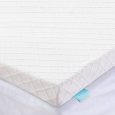
When it comes to getting a good night’s sleep, you know that motion isolation is key. No one wants to be disturbed by their partner’s tossing and turning throughout the night. That’s where a mattress topper comes in. But have you ever wondered what thickness is best for achieving optimal motion isolation? In this article, we will guide you through the process of choosing the right thickness in a mattress topper, so you can finally say goodbye to restless nights and hello to undisturbed sleep.
Factors affecting motion isolation in a mattress topper
When it comes to motion isolation in a mattress topper, there are several factors that can significantly impact its effectiveness. These factors include the material used, the density of the topper, and its firmness. Let’s take a closer look at each of these factors to better understand how they affect motion isolation.
Material
One of the key factors that affect motion isolation in a mattress topper is the material it is made of. Different materials offer different levels of motion isolation. For example, memory foam is known for its excellent motion isolation properties as it absorbs and minimizes movement. On the other hand, latex and innerspring mattress toppers may not be as effective in isolating motion. Therefore, it is important to consider the material of the topper when selecting one for motion isolation purposes.
Density
Another important factor to consider is the density of the mattress topper. Density refers to the amount of material used to make the topper and how tightly it is packed. A higher-density topper will generally offer better motion isolation compared to a lower-density one. This is because a higher-density topper will be more effective at absorbing and distributing weight, reducing the transfer of motion. So, when considering motion isolation, opting for a higher-density mattress topper is generally a good idea.
Firmness
The firmness of a mattress topper also plays a role in its motion isolation capabilities. A firm topper will provide better motion isolation compared to a softer one. This is because a firmer surface will be more effective at absorbing and minimizing movement. However, it is important to strike a balance between firmness and comfort. It is recommended to choose a mattress topper that is firm enough to isolate motion but still comfortable enough for a good night’s sleep.
Importance of thickness in motion isolation
While material, density, and firmness are important factors in motion isolation, thickness also plays a crucial role. The thickness of a mattress topper can greatly impact how well it isolates motion. A thicker topper generally provides better motion isolation compared to a thinner one. This is because a thicker topper creates a greater barrier between the sleeper and the mattress, reducing the transfer of motion.
Considerations when choosing the right thickness
When it comes to choosing the right thickness in a mattress topper for motion isolation, there are several factors to consider. These factors include sleeping position, weight, mattress type, personal preference, temperature regulation, and durability.
Sleeping position
Your sleeping position can influence the ideal thickness for a mattress topper. For side sleepers, a thicker topper may be preferred as it provides extra cushioning for the hips and shoulders. Back and stomach sleepers, on the other hand, may find a thinner topper more comfortable as it provides adequate support without sinking too much.
Weight
Weight is another important consideration when selecting the right thickness for a mattress topper. Heavier individuals may benefit from a thicker topper as it offers better weight distribution and support. Lighter individuals, on the other hand, may find a thinner topper sufficient for their needs.
Mattress type
The type of mattress you have can also influence the ideal thickness for a mattress topper. If you have a firm mattress, a thicker topper can help add extra cushioning and improve motion isolation. If you have a softer mattress, a thinner topper may be more appropriate to avoid sinking too much.
Personal preference
Ultimately, personal preference plays a significant role in choosing the right thickness for a mattress topper. Some individuals may prefer the plush feel of a thicker topper, while others may prefer the firmer support of a thinner topper. It is important to consider your comfort preferences when selecting the thickness of your mattress topper.
Temperature regulation
Another factor to consider is temperature regulation. Thicker mattress toppers may retain more heat compared to thinner ones. If you tend to sleep hot, opting for a thinner topper or one made with cooling materials can help regulate your body temperature and provide a cooler sleep surface.
Durability
Lastly, consider the durability of the mattress topper. Thicker toppers generally have a longer lifespan compared to thinner ones. Thicker options are less likely to compress or break down over time, ensuring that you can enjoy their motion isolation benefits for longer.
Effects of different thickness levels on motion isolation
Now, let’s examine the effects of different thickness levels on motion isolation.
Thin mattress toppers
Thin mattress toppers, typically around 1 to 2 inches thick, may not provide significant motion isolation benefits. While they can add a slight layer of comfort to your mattress, they may not have enough material or thickness to effectively absorb and minimize movement. However, if you do not require much motion isolation and simply want a little extra cushioning, a thin mattress topper may be suitable for your needs.
Medium thickness mattress toppers
Medium thickness mattress toppers, ranging from 3 to 4 inches thick, offer a good balance between comfort and motion isolation. These toppers provide enough material to absorb and minimize movement, ensuring that you and your sleeping partner can enjoy a more undisturbed sleep. Medium thickness toppers are versatile and can work well for various sleeping positions and body weights.
Thick mattress toppers
Thick mattress toppers, typically over 4 inches thick, provide the highest level of motion isolation. These toppers create a substantial barrier between you and the mattress, effectively minimizing the transfer of movement. Thick toppers are ideal for individuals who are highly sensitive to motion or sleep with a partner who frequently tosses and turns during the night. However, it is important to note that thick toppers may significantly alter the overall feel and firmness of the mattress.
Tips for choosing the right thickness
To ensure you choose the right thickness in a mattress topper for motion isolation, consider the following tips:
Try different options
It can be helpful to try out different thickness levels before making a final decision. This way, you can personally experience the comfort and motion isolation benefits offered by each thickness level and determine which one suits you best.
Read customer reviews
Reading customer reviews can provide valuable insights into the motion isolation capabilities of different mattress topper thicknesses. Look for reviews from individuals with similar preferences and sleeping positions to get a better understanding of how a particular thickness level may perform.
Consider your partner
If you sleep with a partner, consider their needs and preferences when selecting the thickness of your mattress topper. Take into account their weight, sleeping position, and sensitivity to motion. Finding a thickness level that works well for both of you can greatly enhance your overall sleep experience.
Consult professionals
If you are still unsure about which thickness to choose, consider consulting with professionals such as sleep experts or mattress retailers. They can provide personalized recommendations based on your specific needs and help guide you towards the right thickness for optimum motion isolation.
Conclusion
Choosing the right thickness in a mattress topper for motion isolation is crucial for creating a comfortable and undisturbed sleep environment. Factors such as material, density, firmness, sleeping position, weight, mattress type, personal preference, temperature regulation, and durability all come into play when selecting the ideal thickness. By considering these factors and following helpful tips, you can ensure that your mattress topper provides excellent motion isolation, allowing you to enjoy a restful night’s sleep without disruption.



